KIA PICANTO 2008 Owners Manual
Manufacturer: KIA, Model Year: 2008, Model line: PICANTO, Model: KIA PICANTO 2008Pages: 335, PDF Size: 12.98 MB
Page 241 of 335
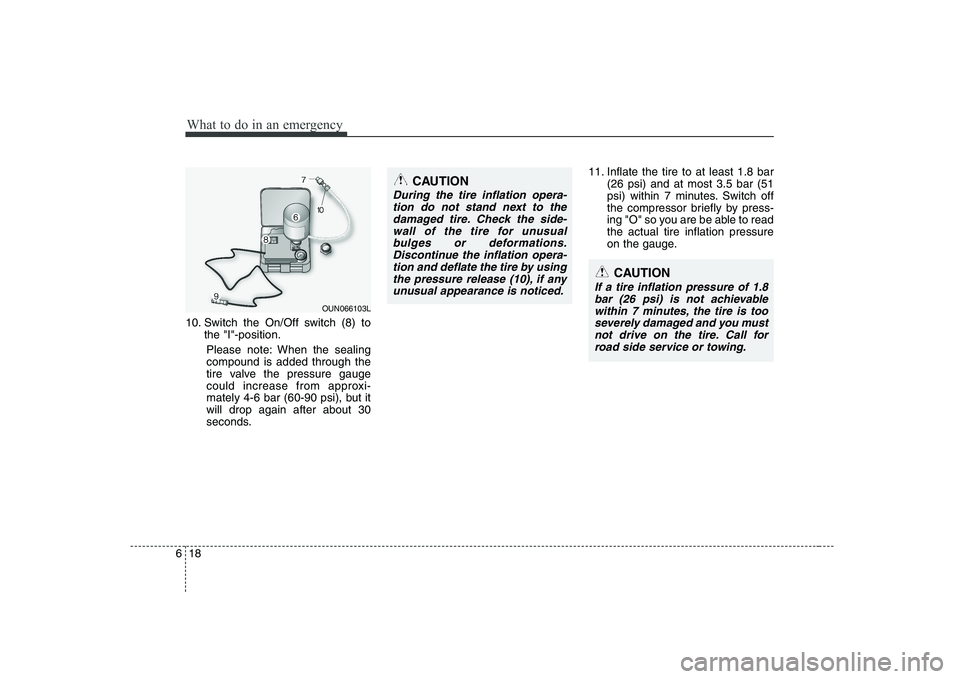
What to do in an emergency
18
6
10. Switch the On/Off switch (8) to
the "I"-position.
Please note: When the sealing compound is added through the
tire valve the pressure gauge
could increase from approxi-
mately 4-6 bar (60-90 psi), but itwill drop again after about 30
seconds. 11. Inflate the tire to at least 1.8 bar
(26 psi) and at most 3.5 bar (51
psi) within 7 minutes. Switch off
the compressor briefly by press-
ing "O" so you are be able to readthe actual tire inflation pressure
on the gauge.
CAUTION
During the tire inflation opera-
tion do not stand next to thedamaged tire. Check the side-wall of the tire for unusual bulges or deformations.Discontinue the inflation opera-tion and deflate the tire by using the pressure release (10), if anyunusual appearance is noticed.
CAUTION
If a tire inflation pressure of 1.8 bar (26 psi) is not achievablewithin 7 minutes, the tire is tooseverely damaged and you must not drive on the tire. Call forroad side service or towing.
OUN066103L
Page 242 of 335
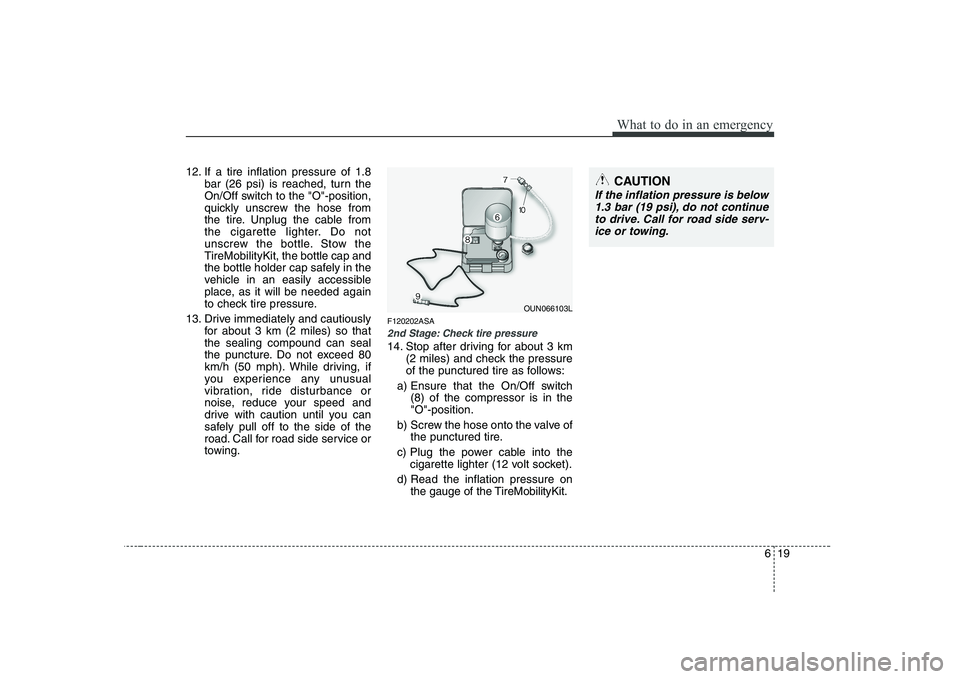
619
What to do in an emergency
12. If a tire inflation pressure of 1.8bar (26 psi) is reached, turn the
On/Off switch to the "O"-position,
quickly unscrew the hose from
the tire. Unplug the cable from
the cigarette lighter. Do not
unscrew the bottle. Stow theTireMobilityKit, the bottle cap and
the bottle holder cap safely in the
vehicle in an easily accessible
place, as it will be needed again
to check tire pressure.
13. Drive immediately and cautiously for about 3 km (2 miles) so thatthe sealing compound can seal
the puncture. Do not exceed 80
km/h (50 mph). While driving, if
you experience any unusual
vibration, ride disturbance or
noise, reduce your speed and
drive with caution until you can
safely pull off to the side of the
road. Call for road side service or
towing. F120202ASA
2nd Stage: Check tire pressure
14. Stop after driving for about 3 km
(2 miles) and check the pressure
of the punctured tire as follows:
a) Ensure that the On/Off switch (8) of the compressor is in the"O"-position.
b) Screw the hose onto the valve of the punctured tire.
c) Plug the power cable into the cigarette lighter (12 volt socket).
d) Read the inflation pressure on the gauge of the TireMobilityKit.
CAUTION
If the inflation pressure is below
1.3 bar (19 psi), do not continueto drive. Call for road side serv- ice or towing.
OUN066103L
Page 243 of 335
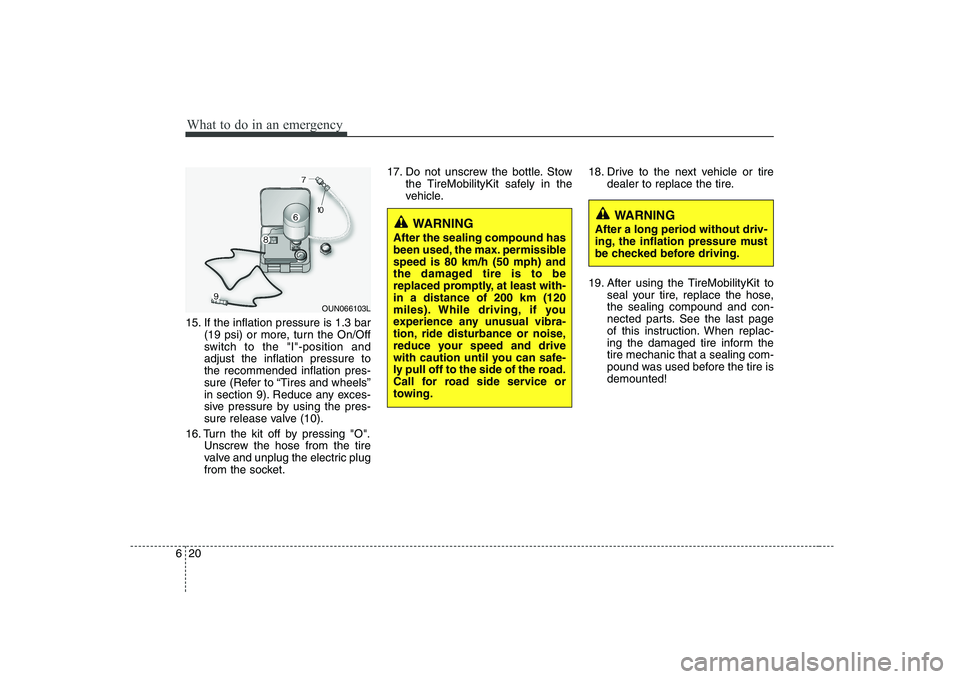
What to do in an emergency
20
6
15. If the inflation pressure is 1.3 bar
(19 psi) or more, turn the On/Off
switch to the "I"-position andadjust the inflation pressure tothe recommended inflation pres-
sure (Refer to “Tires and wheels”
in section 9). Reduce any exces-
sive pressure by using the pres-
sure release valve (10).
16. Turn the kit off by pressing "O". Unscrew the hose from the tire
valve and unplug the electric plug
from the socket. 17. Do not unscrew the bottle. Stow
the TireMobilityKit safely in the
vehicle. 18. Drive to the next vehicle or tire
dealer to replace the tire.
19. After using the TireMobilityKit to seal your tire, replace the hose,the sealing compound and con-
nected parts. See the last page
of this instruction. When replac-
ing the damaged tire inform thetire mechanic that a sealing com-
pound was used before the tire isdemounted!
WARNING
After the sealing compound has
been used, the max. permissiblespeed is 80 km/h (50 mph) and
the damaged tire is to be
replaced promptly, at least with-in a distance of 200 km (120
miles). While driving, if you
experience any unusual vibra-
tion, ride disturbance or noise,
reduce your speed and drive
with caution until you can safe-
ly pull off to the side of the road.
Call for road side service or
towing.WARNING
After a long period without driv-
ing, the inflation pressure must
be checked before driving.
OUN066103L
Page 244 of 335
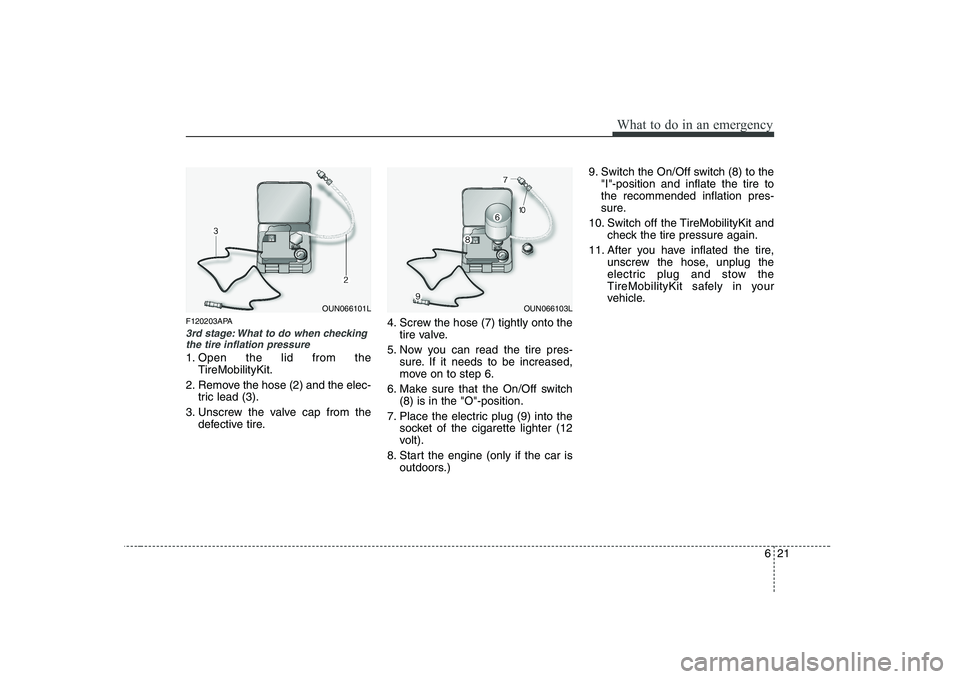
621
What to do in an emergency
F120203APA
3rd stage: What to do when checkingthe tire inflation pressure
1. Open the lid from the
TireMobilityKit.
2. Remove the hose (2) and the elec- tric lead (3).
3. Unscrew the valve cap from the defective tire. 4. Screw the hose (7) tightly onto the
tire valve.
5. Now you can read the tire pres- sure. If it needs to be increased,
move on to step 6.
6. Make sure that the On/Off switch (8) is in the "O"-position.
7. Place the electric plug (9) into the socket of the cigarette lighter (12
volt).
8. Start the engine (only if the car is outdoors.) 9. Switch the On/Off switch (8) to the
"I"-position and inflate the tire tothe recommended inflation pres-
sure.
10. Switch off the TireMobilityKit and check the tire pressure again.
11. After you have inflated the tire, unscrew the hose, unplug the
electric plug and stow the
TireMobilityKit safely in your
vehicle.
OUN066103LOUN066101L
Page 245 of 335
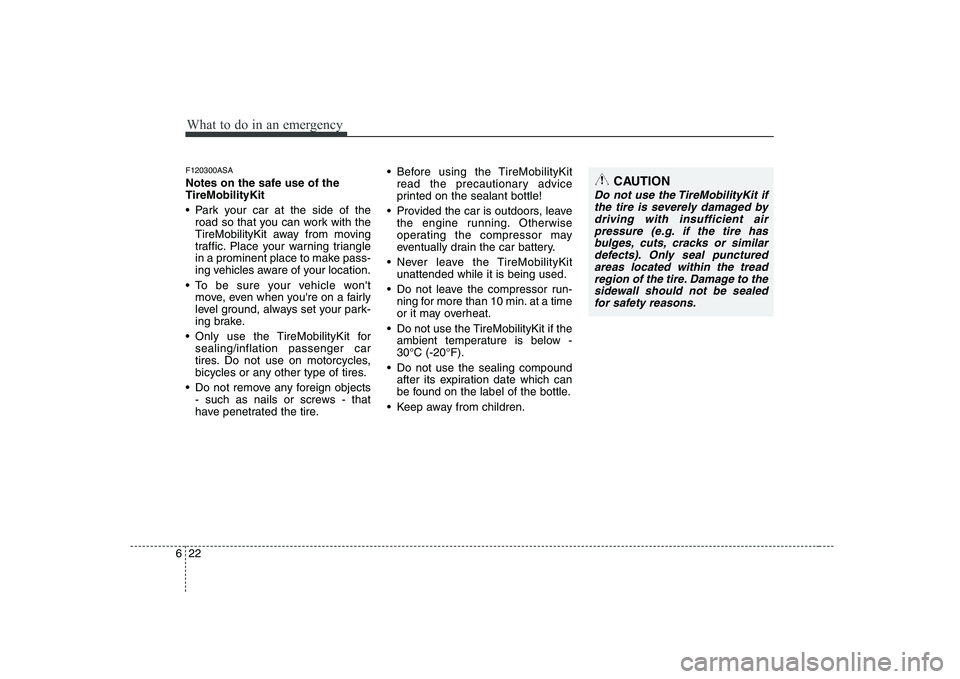
What to do in an emergency
22
6
F120300ASA
Notes on the safe use of the TireMobilityKit
Park your car at the side of the
road so that you can work with the
TireMobilityKit away from moving
traffic. Place your warning triangle
in a prominent place to make pass-
ing vehicles aware of your location.
To be sure your vehicle won't move, even when you're on a fairly
level ground, always set your park-
ing brake.
Only use the TireMobilityKit for sealing/inflation passenger car
tires. Do not use on motorcycles,
bicycles or any other type of tires.
Do not remove any foreign objects - such as nails or screws - that
have penetrated the tire. Before using the TireMobilityKit
read the precautionary advice
printed on the sealant bottle!
Provided the car is outdoors, leave the engine running. Otherwise
operating the compressor may
eventually drain the car battery.
Never leave the TireMobilityKit unattended while it is being used.
Do not leave the compressor run- ning for more than 10 min. at a time
or it may overheat.
Do not use the TireMobilityKit if the ambient temperature is below -30°C (-20°F).
Do not use the sealing compound after its expiration date which can
be found on the label of the bottle.
Keep away from children.
CAUTION
Do not use the TireMobilityKit if the tire is severely damaged bydriving with insufficient airpressure (e.g. if the tire has bulges, cuts, cracks or similardefects). Only seal puncturedareas located within the tread region of the tire. Damage to thesidewall should not be sealedfor safety reasons.
Page 246 of 335
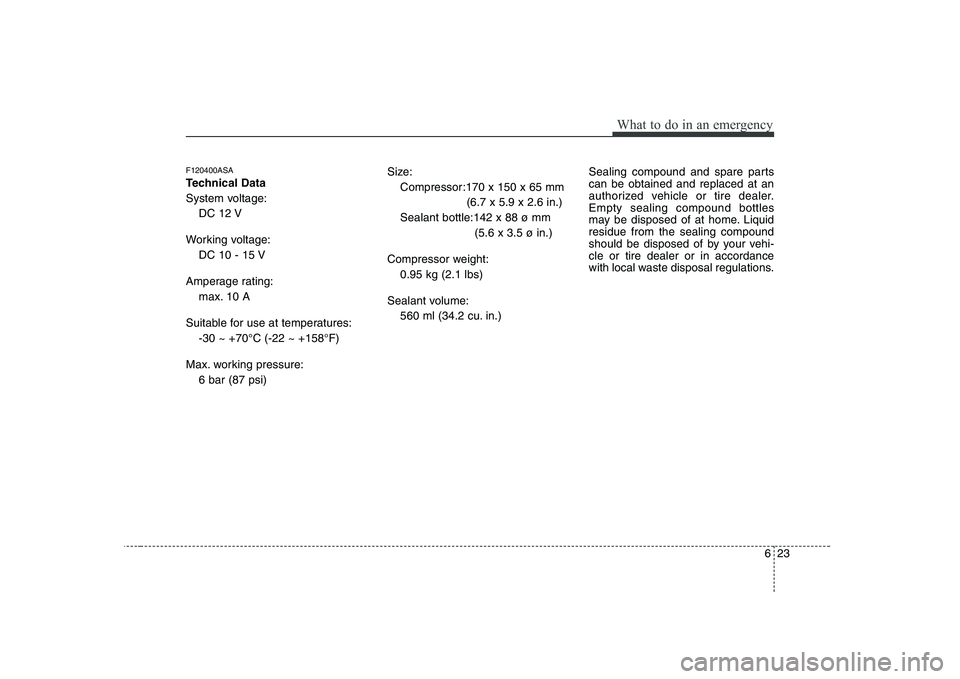
623
What to do in an emergency
F120400ASA
Technical Data
System voltage:DC 12 V
Working voltage: DC 10 - 15 V
Amperage rating: max. 10 A
Suitable for use at temperatures: -30 ~ +70°C (-22 ~ +158°F)
Max. working pressure: 6 bar (87 psi) Size:
Compressor:170 x 150 x 65 mm
(6.7 x 5.9 x 2.6 in.)
Sealant bottle:142 x 88 ø mm
(5.6 x 3.5 ø in.)
Compressor weight: 0.95 kg (2.1 lbs)
Sealant volume: 560 ml (34.2 cu. in.) Sealing compound and spare parts can be obtained and replaced at an
authorized vehicle or tire dealer.Empty sealing compound bottles
may be disposed of at home. Liquidresidue from the sealing compound
should be disposed of by your vehi-cle or tire dealer or in accordance
with local waste disposal regulations.
Page 247 of 335
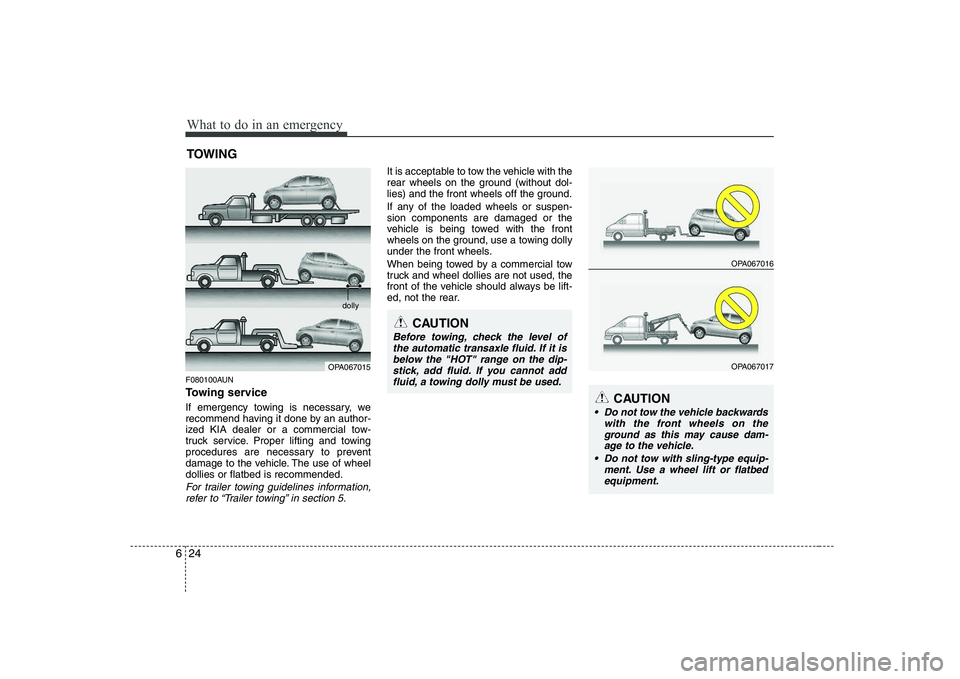
What to do in an emergency
24
6
TOWING
F080100AUN
Towing service
If emergency towing is necessary, we
recommend having it done by an author-
ized KIA dealer or a commercial tow-
truck service. Proper lifting and towing
procedures are necessary to prevent
damage to the vehicle. The use of wheeldollies or flatbed is recommended.
For trailer towing guidelines information, refer to “Trailer towing” in section 5.
It is acceptable to tow the vehicle with the
rear wheels on the ground (without dol-
lies) and the front wheels off the ground.
If any of the loaded wheels or suspen- sion components are damaged or the
vehicle is being towed with the front
wheels on the ground, use a towing dolly
under the front wheels.
When being towed by a commercial tow
truck and wheel dollies are not used, the
front of the vehicle should always be lift-
ed, not the rear.
OPA067015
CAUTION
Before towing, check the level ofthe automatic transaxle fluid. If it is below the "HOT" range on the dip-
stick, add fluid. If you cannot add fluid, a towing dolly must be used.
dolly
OPA067016
OPA067017
CAUTION
Do not tow the vehicle backwards with the front wheels on the
ground as this may cause dam-age to the vehicle.
Do not tow with sling-type equip- ment. Use a wheel lift or flatbedequipment.
Page 248 of 335
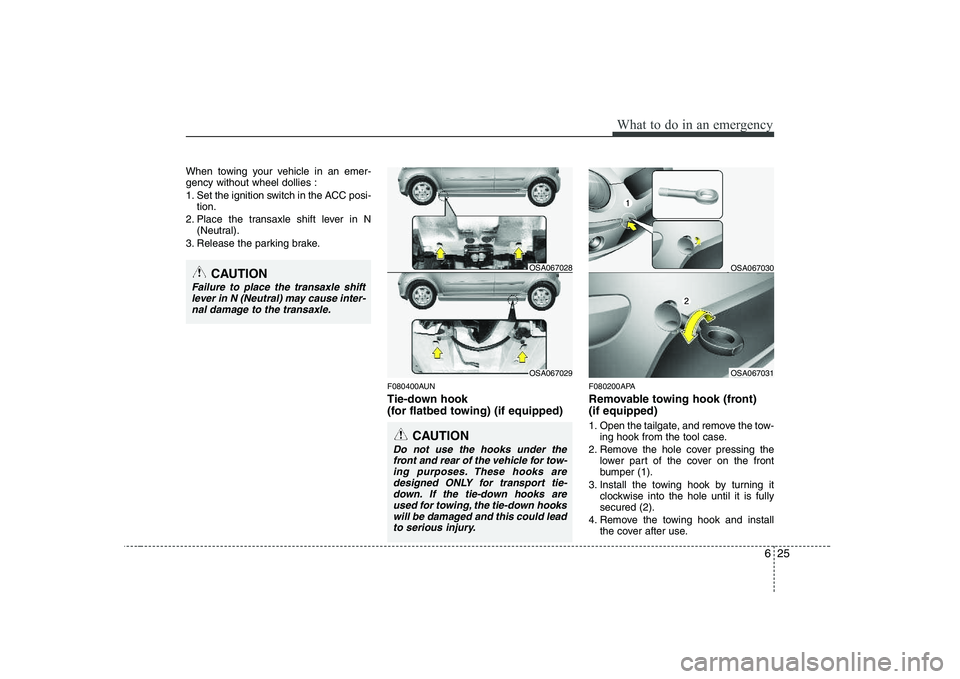
625
What to do in an emergency
When towing your vehicle in an emer- gency without wheel dollies :
1. Set the ignition switch in the ACC posi-tion.
2. Place the transaxle shift lever in N (Neutral).
3. Release the parking brake.
F080400AUN
Tie-down hook
(for flatbed towing) (if equipped)F080200APA
Removable towing hook (front) (if equipped)
1. Open the tailgate, and remove the tow-
ing hook from the tool case.
2. Remove the hole cover pressing the lower part of the cover on the front
bumper (1).
3. Install the towing hook by turning it clockwise into the hole until it is fullysecured (2).
4. Remove the towing hook and install the cover after use.
CAUTION
Failure to place the transaxle shift
lever in N (Neutral) may cause inter-nal damage to the transaxle.
CAUTION
Do not use the hooks under thefront and rear of the vehicle for tow-
ing purposes. These hooks are designed ONLY for transport tie-down. If the tie-down hooks are used for towing, the tie-down hooks
will be damaged and this could leadto serious injury.
OSA067031OSA067029
OSA067028OSA067030
Page 249 of 335
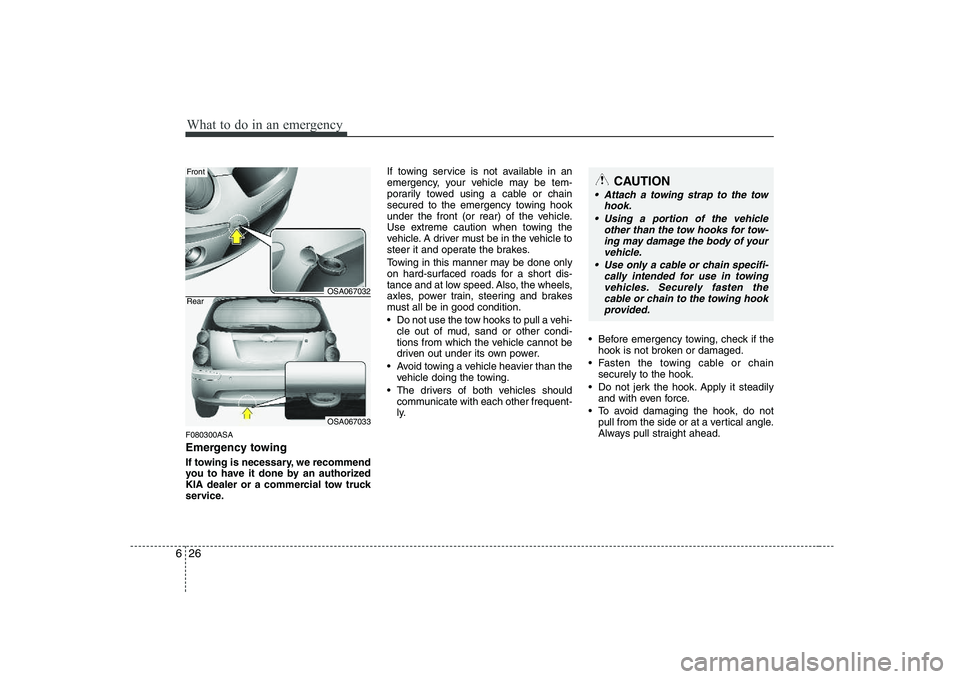
What to do in an emergency
26
6
F080300ASA
Emergency towing
If towing is necessary, we recommend
you to have it done by an authorized
KIA dealer or a commercial tow truck
service. If towing service is not available in an
emergency, your vehicle may be tem-
porarily towed using a cable or chain
secured to the emergency towing hook
under the front (or rear) of the vehicle.
Use extreme caution when towing the
vehicle. A driver must be in the vehicle to
steer it and operate the brakes.
Towing in this manner may be done only
on hard-surfaced roads for a short dis-
tance and at low speed. Also, the wheels,
axles, power train, steering and brakes
must all be in good condition.
Do not use the tow hooks to pull a vehi-
cle out of mud, sand or other condi-
tions from which the vehicle cannot be
driven out under its own power.
Avoid towing a vehicle heavier than the vehicle doing the towing.
The drivers of both vehicles should communicate with each other frequent-
ly. Before emergency towing, check if the
hook is not broken or damaged.
Fasten the towing cable or chain securely to the hook.
Do not jerk the hook. Apply it steadily and with even force.
To avoid damaging the hook, do not pull from the side or at a vertical angle.
Always pull straight ahead.
OSA067032
OSA067033
Front RearCAUTION
Attach a towing strap to the tow
hook.
Using a portion of the vehicle other than the tow hooks for tow-ing may damage the body of your
vehicle.
Use only a cable or chain specifi- cally intended for use in towingvehicles. Securely fasten thecable or chain to the towing hook
provided.
Page 250 of 335
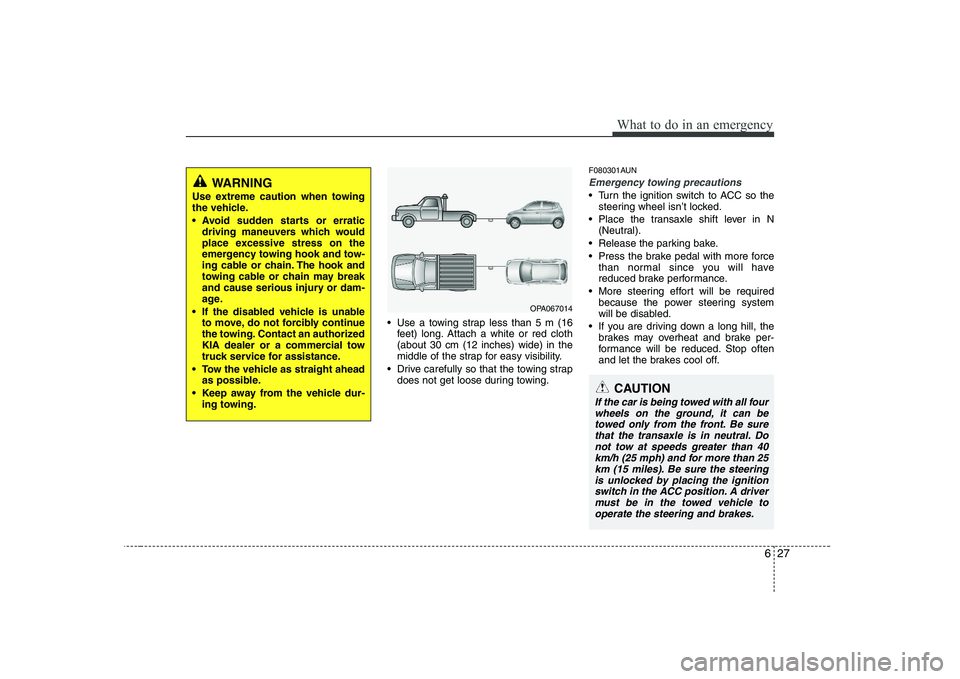
627
What to do in an emergency
Use a towing strap less than 5 m (16feet) long. Attach a white or red cloth (about 30 cm (12 inches) wide) in the
middle of the strap for easy visibility.
Drive carefully so that the towing strap does not get loose during towing. F080301AUN
Emergency towing precautions
Turn the ignition switch to ACC so the
steering wheel isn’t locked.
Place the transaxle shift lever in N (Neutral).
Release the parking bake.
Press the brake pedal with more force than normal since you will have
reduced brake performance.
More steering effort will be required because the power steering system
will be disabled.
If you are driving down a long hill, the brakes may overheat and brake per-
formance will be reduced. Stop often
and let the brakes cool off.
WARNING
Use extreme caution when towing
the vehicle.
driving maneuvers which would
place excessive stress on the
emergency towing hook and tow-
ing cable or chain. The hook and
towing cable or chain may break
and cause serious injury or dam-
age.
If the disabled vehicle is unable to move, do not forcibly continue
the towing. Contact an authorized
KIA dealer or a commercial tow
truck service for assistance.
Tow the vehicle as straight ahead as possible.
Keep away from the vehicle dur- ing towing.
OPA067014
CAUTION
If the car is being towed with all four
wheels on the ground, it can be
towed only from the front. Be sure that the transaxle is in neutral. Do not tow at speeds greater than 40km/h (25 mph) and for more than 25
km (15 miles). Be sure the steeringis unlocked by placing the ignition switch in the ACC position. A drivermust be in the towed vehicle to
operate the steering and brakes.